Qualitative Domestic Violence in Australia: A Criminology Case Review
VerifiedAdded on 2023/06/14
|7
|1525
|274
Case Study
AI Summary
This case study provides a qualitative review of domestic violence in Australia, analyzing the correlation between alcohol density and domestic abuse cases. It examines research aims and questions related to defining domestic violence, identifying risk factors such as alcohol and drug use, evaluating risk groups, and analyzing police intervention in reported cases. The study employs qualitative methods, including participant observation in metropolitan areas, to collect and analyze data, revealing a positive relationship between liquor outlet density and domestic violence rates. It also identifies heavy episodic drinking as a significant risk factor, leading to psychological, emotional, and physical injury. Despite its valuable insights, the study acknowledges limitations such as focusing solely on metropolitan areas, neglecting other contributing factors to domestic violence, and relying primarily on data from Melbourne and police reports. Desklib offers this and other solved assignments and past papers to aid students in their studies.
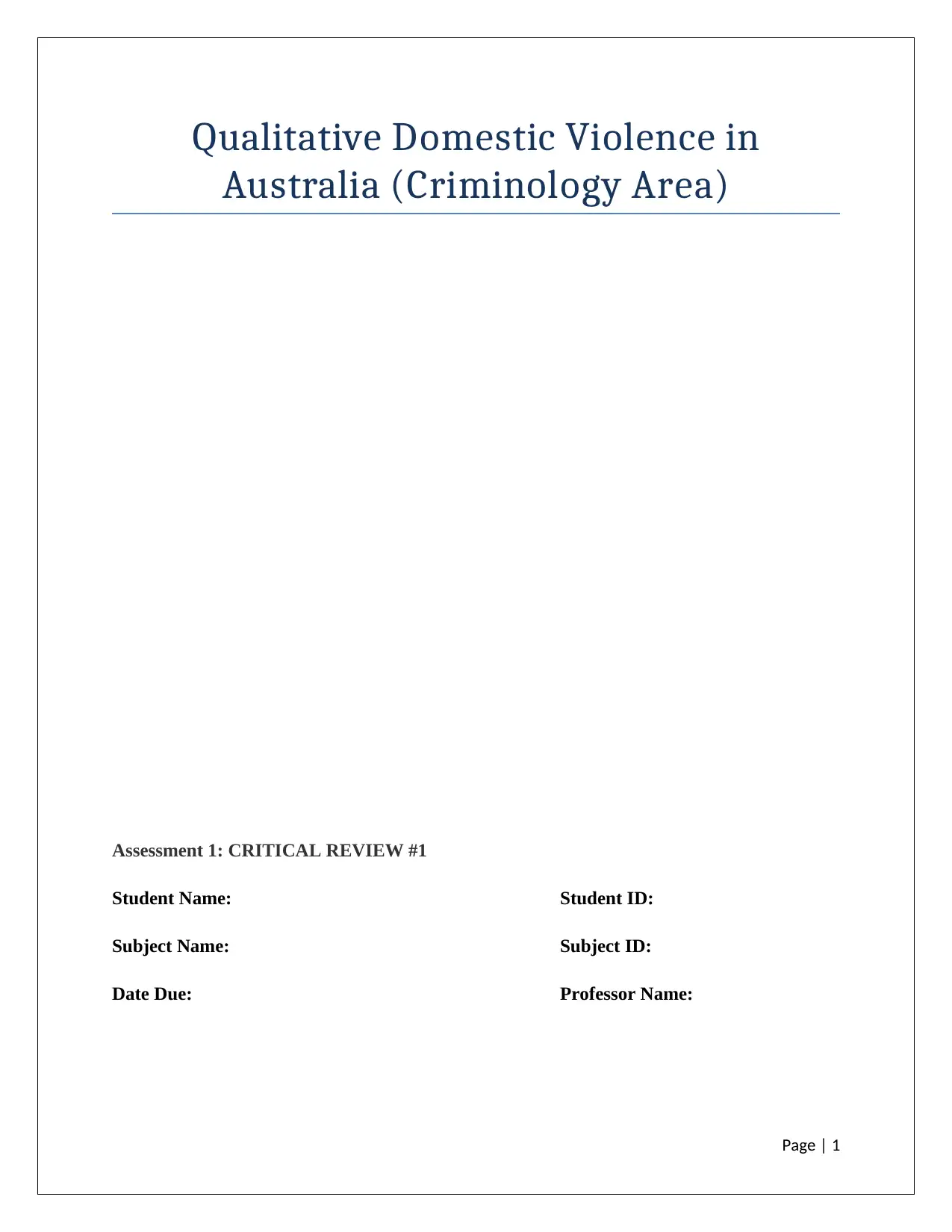
Qualitative Domestic Violence in
Australia (Criminology Area)
Assessment 1: CRITICAL REVIEW #1
Student Name: Student ID:
Subject Name: Subject ID:
Date Due: Professor Name:
Page | 1
Australia (Criminology Area)
Assessment 1: CRITICAL REVIEW #1
Student Name: Student ID:
Subject Name: Subject ID:
Date Due: Professor Name:
Page | 1
Paraphrase This Document
Need a fresh take? Get an instant paraphrase of this document with our AI Paraphraser

1.0 Introduction
The Family Act 1975 defines domestic violence in Australia being a behaviour of a person
threatening to control or coerce members of family to be fearful (Livingston, 2011). The act
primarily refers to violence amongst people having or have had intimate relationship in domestic
setting. Most prevalent form of domestic violence is of men against female partners and also
extends to include same-sex relationships. State’s legislations sometimes applies broader
concepts to include more types of violence, as in Victoria it is referred to as family violence. The
scope of this study analyses qualitatively parliamentary publication of Mitchell (2011) Domestic
violence in Australia: an overview of the issues (Mitchell, 2011). The scope of this journal
evaluates to find correlation between sale of alcohol with that domestic abuse cases. The
reseacrh was udnertaken as a social rescherch program for Federal Government.
2.0 Research Aims and Questions
Domestic violence is a grave criminal offence and is often under reported or avoided. The
scope of this article primary conducts a correlation between alcohol density and rates of domestic
violence in Australia (Hennink, 2010). The scope of the above article evaluates the following
research aims and questions pertaining to the topic.
Research Aim 1: To understand the meaning of domestic violence and its types
prevalence across various parts of the country Research Aim 2: To analyse the risk factors associated with domestic violence,
especially use of alcohol and other drugs Research Aim 3: To evaluate various risk groups facing violence Research Aim 4: To analyse cases that are reported to police for seeking help Research Aim 5: To action taken by police to resolve cases
Page | 2
The Family Act 1975 defines domestic violence in Australia being a behaviour of a person
threatening to control or coerce members of family to be fearful (Livingston, 2011). The act
primarily refers to violence amongst people having or have had intimate relationship in domestic
setting. Most prevalent form of domestic violence is of men against female partners and also
extends to include same-sex relationships. State’s legislations sometimes applies broader
concepts to include more types of violence, as in Victoria it is referred to as family violence. The
scope of this study analyses qualitatively parliamentary publication of Mitchell (2011) Domestic
violence in Australia: an overview of the issues (Mitchell, 2011). The scope of this journal
evaluates to find correlation between sale of alcohol with that domestic abuse cases. The
reseacrh was udnertaken as a social rescherch program for Federal Government.
2.0 Research Aims and Questions
Domestic violence is a grave criminal offence and is often under reported or avoided. The
scope of this article primary conducts a correlation between alcohol density and rates of domestic
violence in Australia (Hennink, 2010). The scope of the above article evaluates the following
research aims and questions pertaining to the topic.
Research Aim 1: To understand the meaning of domestic violence and its types
prevalence across various parts of the country Research Aim 2: To analyse the risk factors associated with domestic violence,
especially use of alcohol and other drugs Research Aim 3: To evaluate various risk groups facing violence Research Aim 4: To analyse cases that are reported to police for seeking help Research Aim 5: To action taken by police to resolve cases
Page | 2

In order to answer the above research aims the following questions has to be answered (Taylor,
2015).
Research Question 1: What are the various definitions of domestic violence used across
Australia?
Research Question 2: What are the prevalent types of domestic violence?
Research Question 3: Who are the risk groups facing domestic violence?
Research Question 4: How many cases of domestic violence are reported to police?
Research Question 5: What is the action taken by police to resolve cases reported of
domestic violence?
3.0 Qualitative Method evaluation
The journal is an integral paper that understands the correlation between liquor license rate,
reports made to police authorities in a given area with that of domestic violence rate from local
police data. The author of the paper has adopted qualitative methods of evaluation by collection
of data from various parts of Australia (Tracy, 2012). Subjective data was appropriate and used
for the purpose of the study to draw correlation between variables proposed. The scholar mostly
adopted data collection from metropolitan areas of Australia. The article conducts research in
area that had not been attempted earlier in Australia. The scholar adopted participant
observation. The participants in the observation comprised mainly of mixed characteristics of
Aboriginals and other Australians (Lewis, 2015). Though the observation had been conducted
across specific post codes only but it was suited for the specific study as reported incidence to
police at these post codes were higher compared to other regions. Each participant was well-
suited for the purpose of data collection as data obtained was specific. Participant observation
Page | 3
2015).
Research Question 1: What are the various definitions of domestic violence used across
Australia?
Research Question 2: What are the prevalent types of domestic violence?
Research Question 3: Who are the risk groups facing domestic violence?
Research Question 4: How many cases of domestic violence are reported to police?
Research Question 5: What is the action taken by police to resolve cases reported of
domestic violence?
3.0 Qualitative Method evaluation
The journal is an integral paper that understands the correlation between liquor license rate,
reports made to police authorities in a given area with that of domestic violence rate from local
police data. The author of the paper has adopted qualitative methods of evaluation by collection
of data from various parts of Australia (Tracy, 2012). Subjective data was appropriate and used
for the purpose of the study to draw correlation between variables proposed. The scholar mostly
adopted data collection from metropolitan areas of Australia. The article conducts research in
area that had not been attempted earlier in Australia. The scholar adopted participant
observation. The participants in the observation comprised mainly of mixed characteristics of
Aboriginals and other Australians (Lewis, 2015). Though the observation had been conducted
across specific post codes only but it was suited for the specific study as reported incidence to
police at these post codes were higher compared to other regions. Each participant was well-
suited for the purpose of data collection as data obtained was specific. Participant observation
Page | 3
⊘ This is a preview!⊘
Do you want full access?
Subscribe today to unlock all pages.

Trusted by 1+ million students worldwide
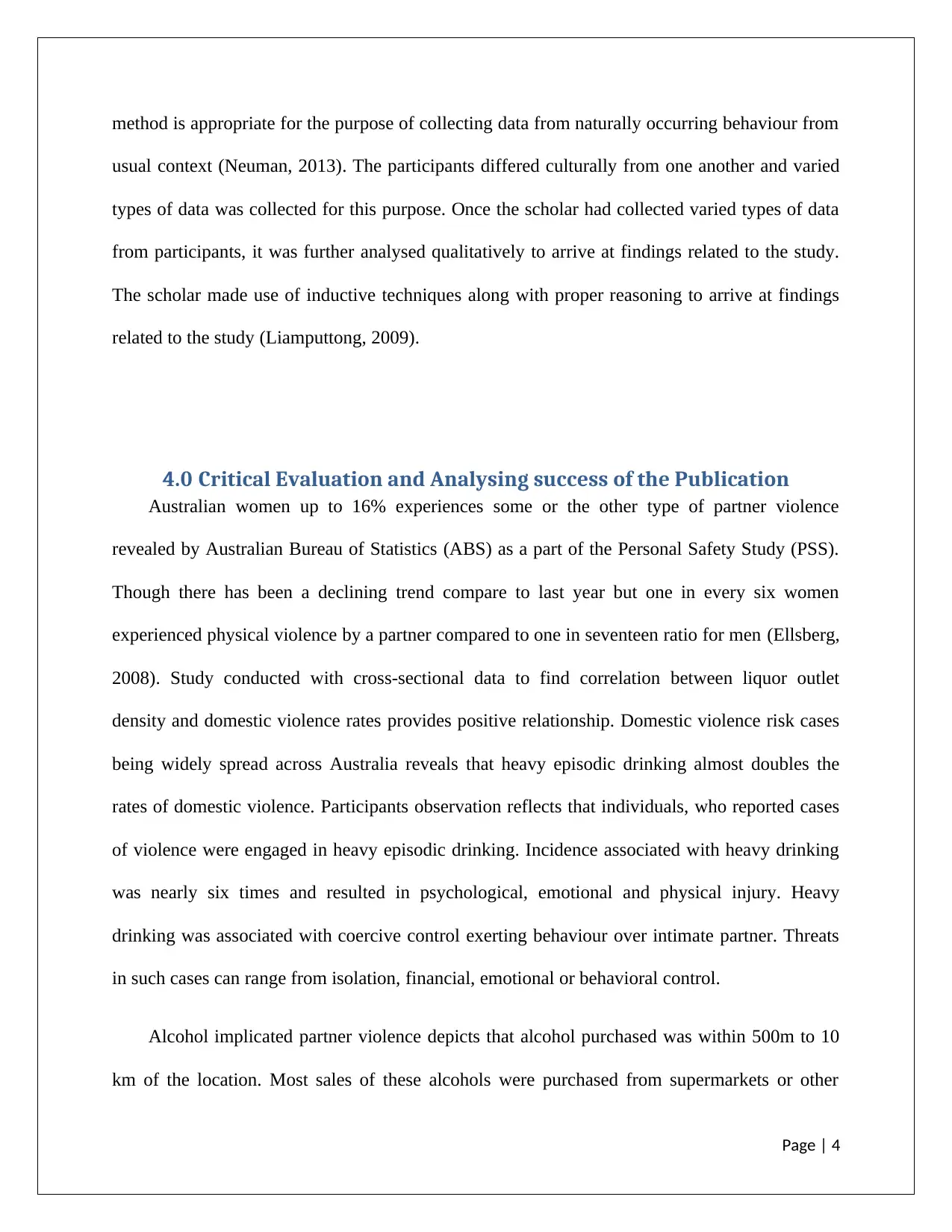
method is appropriate for the purpose of collecting data from naturally occurring behaviour from
usual context (Neuman, 2013). The participants differed culturally from one another and varied
types of data was collected for this purpose. Once the scholar had collected varied types of data
from participants, it was further analysed qualitatively to arrive at findings related to the study.
The scholar made use of inductive techniques along with proper reasoning to arrive at findings
related to the study (Liamputtong, 2009).
4.0 Critical Evaluation and Analysing success of the Publication
Australian women up to 16% experiences some or the other type of partner violence
revealed by Australian Bureau of Statistics (ABS) as a part of the Personal Safety Study (PSS).
Though there has been a declining trend compare to last year but one in every six women
experienced physical violence by a partner compared to one in seventeen ratio for men (Ellsberg,
2008). Study conducted with cross-sectional data to find correlation between liquor outlet
density and domestic violence rates provides positive relationship. Domestic violence risk cases
being widely spread across Australia reveals that heavy episodic drinking almost doubles the
rates of domestic violence. Participants observation reflects that individuals, who reported cases
of violence were engaged in heavy episodic drinking. Incidence associated with heavy drinking
was nearly six times and resulted in psychological, emotional and physical injury. Heavy
drinking was associated with coercive control exerting behaviour over intimate partner. Threats
in such cases can range from isolation, financial, emotional or behavioral control.
Alcohol implicated partner violence depicts that alcohol purchased was within 500m to 10
km of the location. Most sales of these alcohols were purchased from supermarkets or other
Page | 4
usual context (Neuman, 2013). The participants differed culturally from one another and varied
types of data was collected for this purpose. Once the scholar had collected varied types of data
from participants, it was further analysed qualitatively to arrive at findings related to the study.
The scholar made use of inductive techniques along with proper reasoning to arrive at findings
related to the study (Liamputtong, 2009).
4.0 Critical Evaluation and Analysing success of the Publication
Australian women up to 16% experiences some or the other type of partner violence
revealed by Australian Bureau of Statistics (ABS) as a part of the Personal Safety Study (PSS).
Though there has been a declining trend compare to last year but one in every six women
experienced physical violence by a partner compared to one in seventeen ratio for men (Ellsberg,
2008). Study conducted with cross-sectional data to find correlation between liquor outlet
density and domestic violence rates provides positive relationship. Domestic violence risk cases
being widely spread across Australia reveals that heavy episodic drinking almost doubles the
rates of domestic violence. Participants observation reflects that individuals, who reported cases
of violence were engaged in heavy episodic drinking. Incidence associated with heavy drinking
was nearly six times and resulted in psychological, emotional and physical injury. Heavy
drinking was associated with coercive control exerting behaviour over intimate partner. Threats
in such cases can range from isolation, financial, emotional or behavioral control.
Alcohol implicated partner violence depicts that alcohol purchased was within 500m to 10
km of the location. Most sales of these alcohols were purchased from supermarkets or other
Page | 4
Paraphrase This Document
Need a fresh take? Get an instant paraphrase of this document with our AI Paraphraser
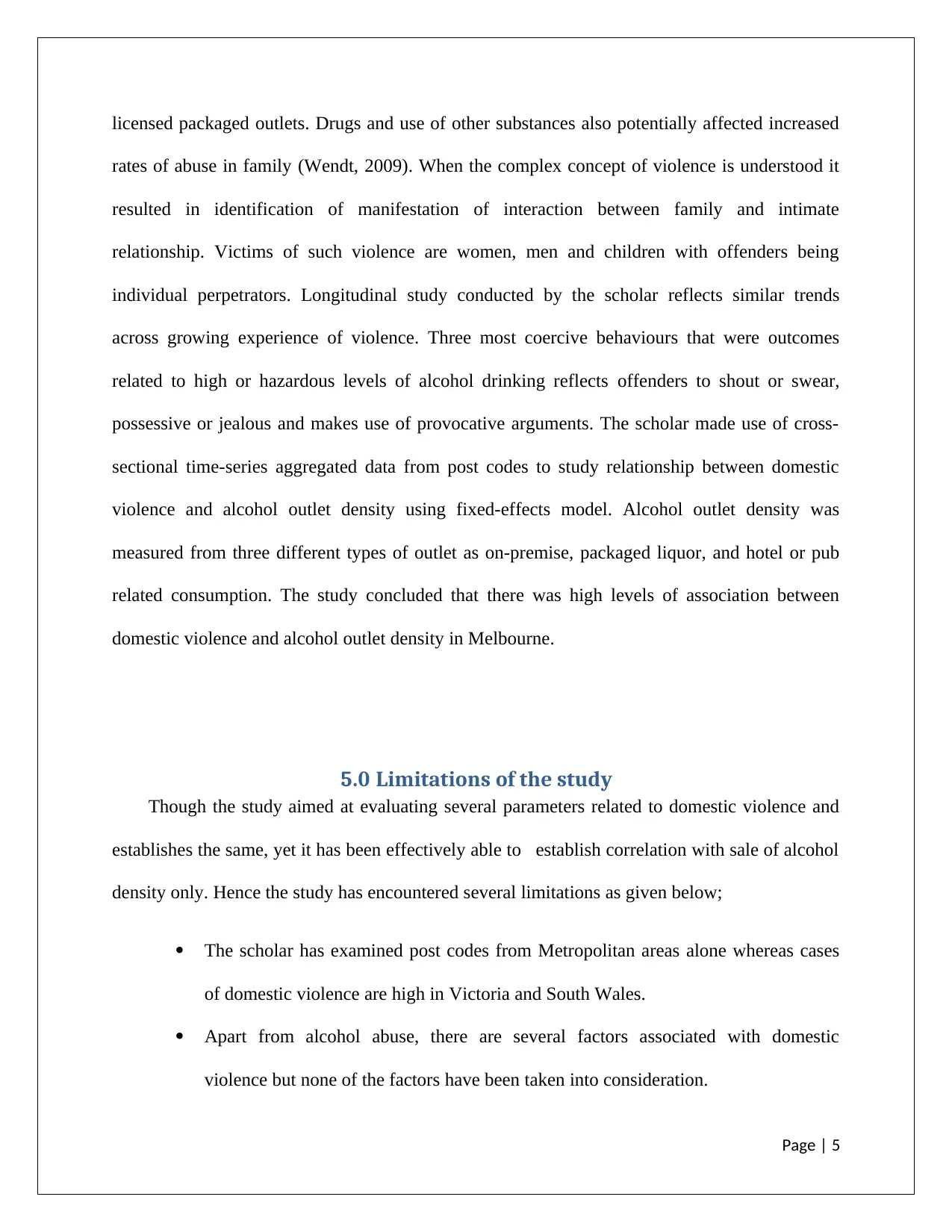
licensed packaged outlets. Drugs and use of other substances also potentially affected increased
rates of abuse in family (Wendt, 2009). When the complex concept of violence is understood it
resulted in identification of manifestation of interaction between family and intimate
relationship. Victims of such violence are women, men and children with offenders being
individual perpetrators. Longitudinal study conducted by the scholar reflects similar trends
across growing experience of violence. Three most coercive behaviours that were outcomes
related to high or hazardous levels of alcohol drinking reflects offenders to shout or swear,
possessive or jealous and makes use of provocative arguments. The scholar made use of cross-
sectional time-series aggregated data from post codes to study relationship between domestic
violence and alcohol outlet density using fixed-effects model. Alcohol outlet density was
measured from three different types of outlet as on-premise, packaged liquor, and hotel or pub
related consumption. The study concluded that there was high levels of association between
domestic violence and alcohol outlet density in Melbourne.
5.0 Limitations of the study
Though the study aimed at evaluating several parameters related to domestic violence and
establishes the same, yet it has been effectively able to establish correlation with sale of alcohol
density only. Hence the study has encountered several limitations as given below;
The scholar has examined post codes from Metropolitan areas alone whereas cases
of domestic violence are high in Victoria and South Wales.
Apart from alcohol abuse, there are several factors associated with domestic
violence but none of the factors have been taken into consideration.
Page | 5
rates of abuse in family (Wendt, 2009). When the complex concept of violence is understood it
resulted in identification of manifestation of interaction between family and intimate
relationship. Victims of such violence are women, men and children with offenders being
individual perpetrators. Longitudinal study conducted by the scholar reflects similar trends
across growing experience of violence. Three most coercive behaviours that were outcomes
related to high or hazardous levels of alcohol drinking reflects offenders to shout or swear,
possessive or jealous and makes use of provocative arguments. The scholar made use of cross-
sectional time-series aggregated data from post codes to study relationship between domestic
violence and alcohol outlet density using fixed-effects model. Alcohol outlet density was
measured from three different types of outlet as on-premise, packaged liquor, and hotel or pub
related consumption. The study concluded that there was high levels of association between
domestic violence and alcohol outlet density in Melbourne.
5.0 Limitations of the study
Though the study aimed at evaluating several parameters related to domestic violence and
establishes the same, yet it has been effectively able to establish correlation with sale of alcohol
density only. Hence the study has encountered several limitations as given below;
The scholar has examined post codes from Metropolitan areas alone whereas cases
of domestic violence are high in Victoria and South Wales.
Apart from alcohol abuse, there are several factors associated with domestic
violence but none of the factors have been taken into consideration.
Page | 5
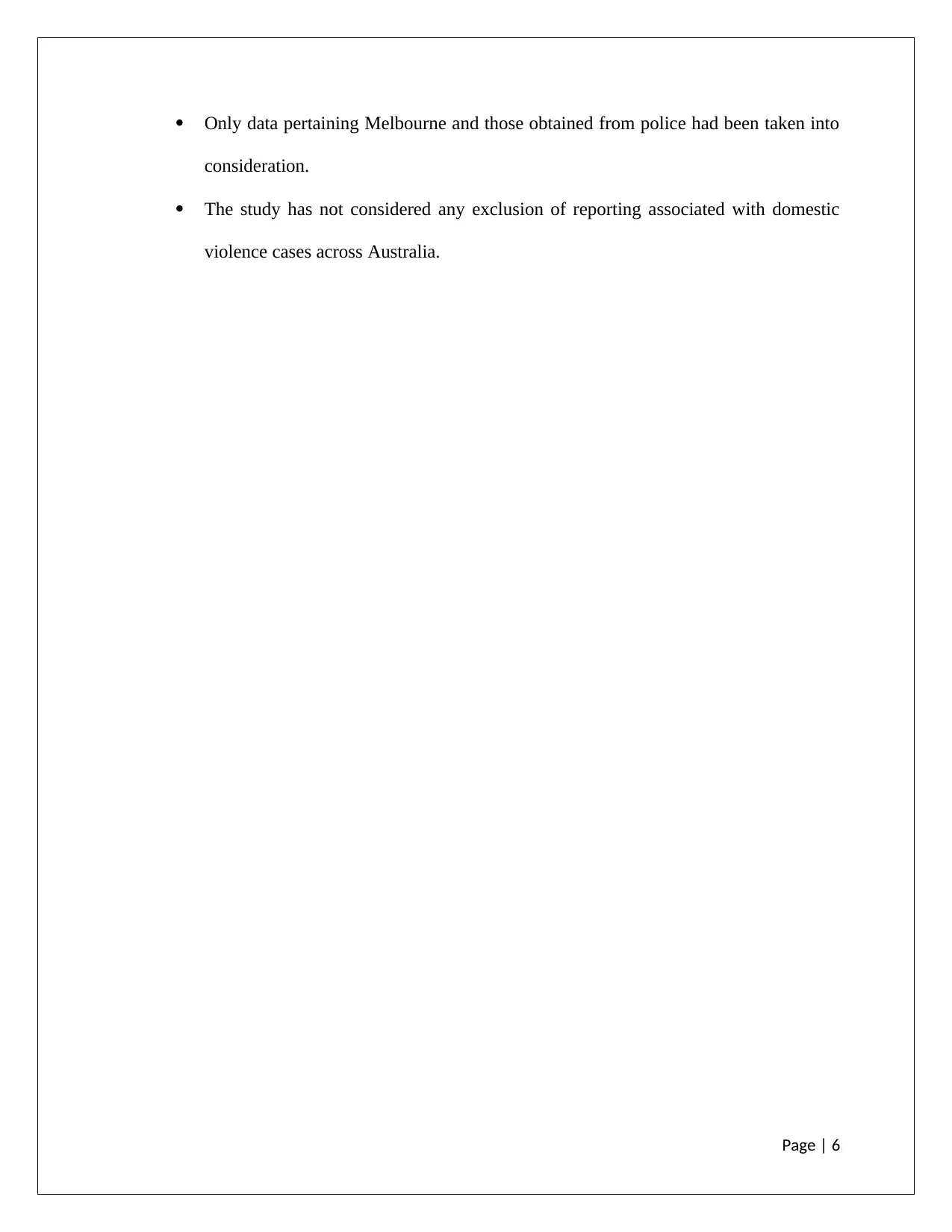
Only data pertaining Melbourne and those obtained from police had been taken into
consideration.
The study has not considered any exclusion of reporting associated with domestic
violence cases across Australia.
Page | 6
consideration.
The study has not considered any exclusion of reporting associated with domestic
violence cases across Australia.
Page | 6
⊘ This is a preview!⊘
Do you want full access?
Subscribe today to unlock all pages.

Trusted by 1+ million students worldwide
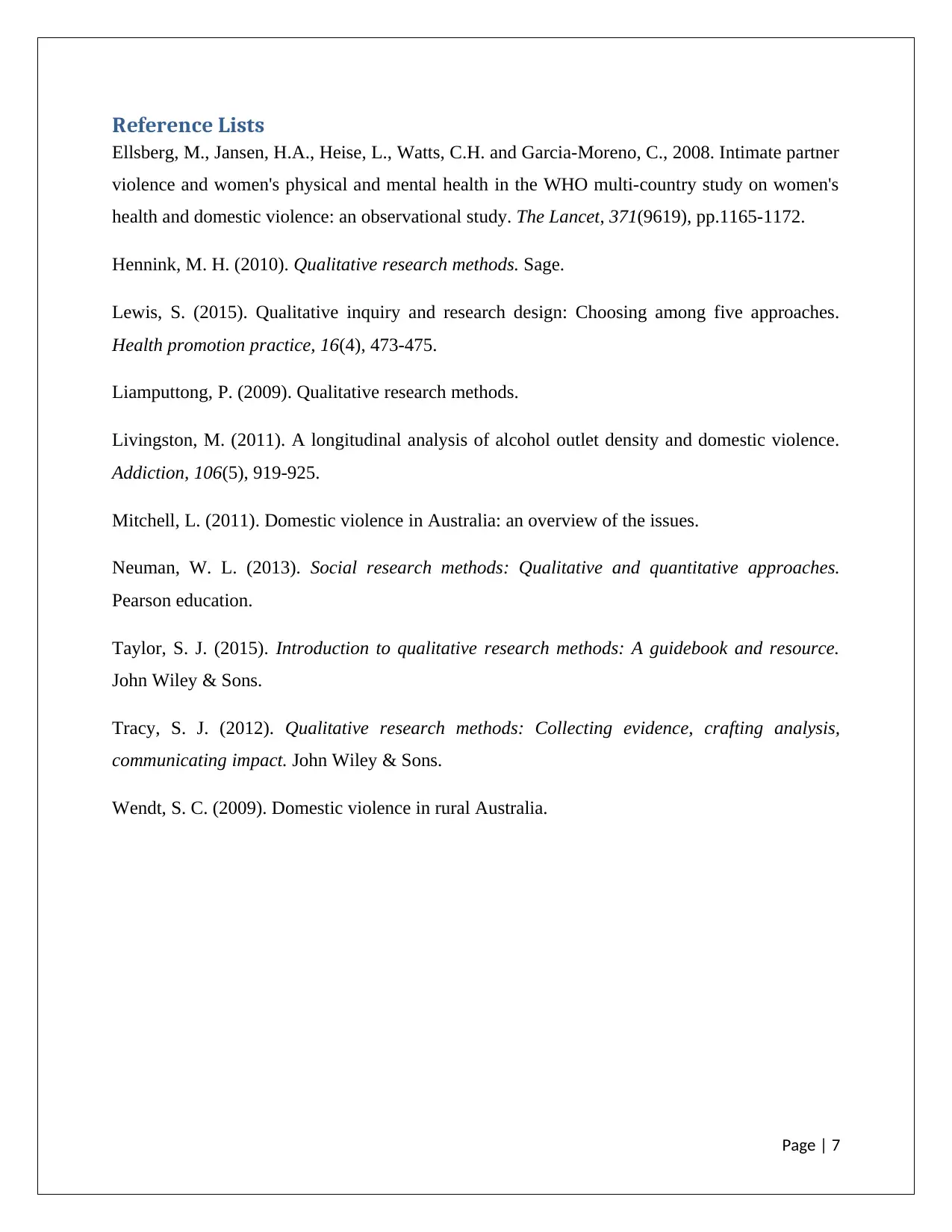
Reference Lists
Ellsberg, M., Jansen, H.A., Heise, L., Watts, C.H. and Garcia-Moreno, C., 2008. Intimate partner
violence and women's physical and mental health in the WHO multi-country study on women's
health and domestic violence: an observational study. The Lancet, 371(9619), pp.1165-1172.
Hennink, M. H. (2010). Qualitative research methods. Sage.
Lewis, S. (2015). Qualitative inquiry and research design: Choosing among five approaches.
Health promotion practice, 16(4), 473-475.
Liamputtong, P. (2009). Qualitative research methods.
Livingston, M. (2011). A longitudinal analysis of alcohol outlet density and domestic violence.
Addiction, 106(5), 919-925.
Mitchell, L. (2011). Domestic violence in Australia: an overview of the issues.
Neuman, W. L. (2013). Social research methods: Qualitative and quantitative approaches.
Pearson education.
Taylor, S. J. (2015). Introduction to qualitative research methods: A guidebook and resource.
John Wiley & Sons.
Tracy, S. J. (2012). Qualitative research methods: Collecting evidence, crafting analysis,
communicating impact. John Wiley & Sons.
Wendt, S. C. (2009). Domestic violence in rural Australia.
Page | 7
Ellsberg, M., Jansen, H.A., Heise, L., Watts, C.H. and Garcia-Moreno, C., 2008. Intimate partner
violence and women's physical and mental health in the WHO multi-country study on women's
health and domestic violence: an observational study. The Lancet, 371(9619), pp.1165-1172.
Hennink, M. H. (2010). Qualitative research methods. Sage.
Lewis, S. (2015). Qualitative inquiry and research design: Choosing among five approaches.
Health promotion practice, 16(4), 473-475.
Liamputtong, P. (2009). Qualitative research methods.
Livingston, M. (2011). A longitudinal analysis of alcohol outlet density and domestic violence.
Addiction, 106(5), 919-925.
Mitchell, L. (2011). Domestic violence in Australia: an overview of the issues.
Neuman, W. L. (2013). Social research methods: Qualitative and quantitative approaches.
Pearson education.
Taylor, S. J. (2015). Introduction to qualitative research methods: A guidebook and resource.
John Wiley & Sons.
Tracy, S. J. (2012). Qualitative research methods: Collecting evidence, crafting analysis,
communicating impact. John Wiley & Sons.
Wendt, S. C. (2009). Domestic violence in rural Australia.
Page | 7
1 out of 7
Related Documents
Your All-in-One AI-Powered Toolkit for Academic Success.
+13062052269
info@desklib.com
Available 24*7 on WhatsApp / Email
![[object Object]](/_next/static/media/star-bottom.7253800d.svg)
Unlock your academic potential
Copyright © 2020–2025 A2Z Services. All Rights Reserved. Developed and managed by ZUCOL.




